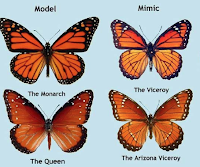Chemical Warfare
It's easy to forget, when you're peeling a beetle carcass of the bottom of your shoe, that insects are some of the fiercest animals in the kingdom. They don't let predators take advantage of their small size, often sporting sharp needles and spines on their exoskeleton, blending into their habitat, feigning their own death, or stinging anything that dares to get too close (Evans 1984). Most impressive of all are the insects able to secrete chemicals that ward off predators. These chemicals may either be acquired in some way from the host plant, for example sawfly larvae which regurgitate pine tree resin, or synthesized by the insect itself; these chemicals are then utilized via different methods of excretion (Eisner 2003). Although foul smelling, foul tasting, excessively sticky, or mildly acidic compounds may not seem like a big deal to humanoid giants, they are effective against smaller attackers.
Insect chemical defenses are stored in the hemolymph and excreted via bleeding or stored in excretory glands and excreted from these glands. Chemicals sequestered in the glands have a greater capacity for toxicity, because an impervious cuticle protects the remainder of the insect organs from exposure. Additionally, these chemicals are sometimes produced in steps, not becoming dangerous, or posing a threat to the prey insect, until the last element is added (Evans 1984). Using a mixture of chemicals for defense is a smart adaptive advantage for insects because they are able to pose a threat to a greater diversity of predators (Blum 2012). The bleeding that releases defense chemicals is referred to as "reflexive" and often occurs as an ooze at weak joints on the legs, antennae, or sclerotized plates of the exoskeleton. Lady Beetles use this method of bleeding when threatened, releasing a foul smelling repellent that contains various alkaloid toxins through their leg joints (Aristizbal 2014).
Redheaded Pine Sawfly Larvae https://bugguide.net/node/view/369698
Adult Seven Spotted Lady Beetle http://brookerpestcontrol.com/bug/sevenspotted-lady-beetle/
Many hypothesize that the bright colors of the lady beetle are aposematic, to warn prey of their ill-smelling fate should they fancy a coleoptera delicacy. This coloration is common in insects with chemical defenses, and, in fact, many non-threatening insect species adopt the same coloration to ward off predators in a form of mimicry (Evans 1984). Predators, then, are left to play chicken with the orange/red, spotted insects. Monarch butterflies cope with such imposters as well; their larvae sequester cardiac glycerides from milkweed leaves, their host plant, which induce vomiting in any predators that ingests them (Blum 2012). Like a bad case of food poisoning, the sorry bird quickly learns to stay away from orange and black wings.
Monarch Butterflies and several mimic species http://www.ruangan.co/what-butterfly-mimics-the-monarch-butterfly/
When one insect doesn't have all of the tools to ward of predators solo, they can pool their resources for a team effort. For example, soldier termites have two variations- one type with a large mandible and one type with a large frontal gland that secretes ketones. The mandible acts as the main form of defense. The secretions are irritating to some predators, but more importantly, they signal other members of the tribe to help mount a defense. A. V. Evans describes the mounted defense as, "an advance outward in a parallel or staggered line, precisely spaced by just the distance of antennal contact (p. 134)." Such coordination would not be possible without the ketone warning.
Soldier Termites https://www.terminix.com/blog/bug-facts/getting-to-know-soldier-termites/
Bombardier Beetles are perhaps the most infamous of all the chemically defended insects. They live in temperate woodlands and grasslands with vegetation for them to hide away under. More than 40 species exist in the Unites States, often with blue elytra and a red-tinted body (Evans 2007). Upon grasping the beetles, they omit audible pops, followed by the release of a cloud of acrid mist that burns mildly and stains the hands with brown speckles (watch a video here). They are releasing the chemical benzoquinone from endocrine glands on the sides of their body. These glands jointly open up from the end of the abdomen, forming a single opening that can aim like a gun (Eisner 2003). The abdominal tip through which the chemical sprays can be rotated up to 270 degrees, so that they can fire at predators from every which way (Evans 2007). Aptly named, Bombardier Beetles are truly a military-level threat in the insect kingdom.
Bombardier Beetle https://indianapublicmedia.org/amomentofscience/bombardier-beetle-2/
References:
Aristizabal, Arthurs. "Convergent Lady Beetle, Hippodamia convergens." UF?IFAS Featured Creatures. 2014.
Blum, Murray. Chemical Defenses of Arthropods. Academic Press: New York, NY 1981.
Evans, Howard. Insect Biology: A Textbook of Entomology. Addison- Wesley Publishing Co.: Reading, MA 1984.
Evans A.V. National Wildlife Federation Field Guide to Insects and Spiders of North America. Sterling Publishing Co., Inc.: New York, NY 2007.
Eisner, Thomas. For Love of Insects. The Belknap Press of Harvard University Press: Cambridge, MA 2003.







Comments
Post a Comment